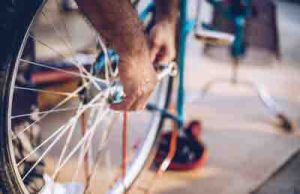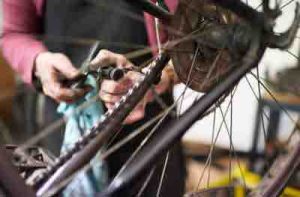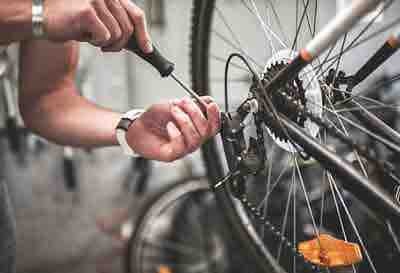There is a loud echo on the need to tune up your bike. The need for a bike tune-up stems from the fact that your bike needs to be cleaned, realigned, and serviced.
But, is there a big deal with bike tune-up? Is it worth paying for a bike tune-up? Why can’t you just clean your bikes by yourself?
Is a bike tune-up worth it? Yes, a bike tune-up is worth it and very important. A bike tune-up handles the overall maintenance of your bike, bringing it back to a brand new shape.
Bike tune-up handles the process of inspecting your bike bottom bracket, greasing your threads, working on the drivetrain, wheels, headset, brakes, and all fundamental parts of the bike.
It includes repairs and adjustment of the required parts and replacing them with new parts when the need arises.
You might decide to do all these by yourself, but you might not achieve the level of expertise and the time required for a perfect bike tune-up.
Having a professional repairman work on your bike tune-up increases the durability of the bike.
Table of Contents
Importance of bike tune-up (explained)

It becomes difficult for you to book a bike tune-up service if you do not understand the importance of doing so. There are a lot of reasons why properly maintaining your bike with a bike tune-up is worth it.
Here are five importance of a bike tune-up:
- Improves bike performance
- Cost savings
- Ensures riders’ safety
- Better ride
- Improved positioning
1. Improves bike’s performance
A regular bike tune-up ensures that the bike is at optimum performance. A bike tune-up handles the cleaning and greasing of the bike’s bearings, drivetrain, adjustment, and alignment.
More importantly, faulty parts are easily spotted during a bike tune-up.
These activities reduce the rolling resistance of your tires, improve handling and balance maintenance. A bike tune-up includes a thorough inspection of your bike.
This ensures that the tires get pumped to the accurate pressure, and the cords are perfectly fixed. Cleaning and aligning the wheels inclusive.
In this scenario, you are sure of achieving better traction, and balance; there is an assurance of grip, and speed after a bike tune-up.
2. Cost Savings
This is one of the importance of bike tune-up that a lot of riders tend to ignore. When your bike is constantly maintained and serviced in a bike tune-up, you eliminate the cost of repairs during the breakdown.
For instance, instead of waiting till your misaligned wheels break down, you can book a bike tuneup service and prevent the foreseen damage.
This will only make you spend lesser on a bike tuneup than you will spend on a replacement.
Bike tune-ups come in different categories. Each bike tuneup service provider decides their categories and the level of servicing and maintenance that they offer during that time.
The wellbeing of the bike determines the category of a tuneup for your bike. However, no matter the condition of your bike, it is cheaper to have a repairman tune up your bike, than to purchase new parts.
3. Rider’s Safety
Unaligned and poorly maintained biked parts are major causes of road accidents. The bike tune-up includes crucial processes that determine the safety of the rider.
Some of these processes include;
- Servicing the drivetrain
- Greasing, degreasing, general cleaning
- Wheels care and alignment
- Gears and brake adjustment
- Headset and bottom bracket adjustment
The entire process of a bike tuneup is not limited to putting the bike in condition but also ensuring that it passes the safety check.
This includes ensuring that tires meet the exact pressure. For you to prevent an emergency pop, crack, or damage that might pose danger to your life, you should see bike tuneup as a mandatory bike maintenance process.
4. Better Ride
When your tires are in good shape, filled with the appropriate pressure, with a well-aligned wheel and bottom bracket, you will enjoy a smoother and better ride.
A tuneup expert will analyze your bike, service all parts, and ensure that your bike is in good shape.
5. Improved Positioning
We underestimate the process of riding an ergonomically designed bike. The positioning of your body to the bike affects your ride.
More importantly, you wouldn’t want to develop a bad posture from a poorly positioned bike. Bike tuneup services include adjusting your handlebars, seats, pedals, and crank.
These little touches ensure that you are sitting well and cycling comfortably. This also improves the durability and life span of the bike. With proper distribution of weight and pressure, prevention of damages.
Questions you must ask before a bike tune-up
Finally, you are about to book an appointment to have your bike tuned up. What are questions you must ask before tune-up?
You may skip the necessary questions and start with questions like; Is it worth paying for a bike tune-up?
As a first-timer, it is normal to skip valid questions and focus on the cost of tuning up your bike.
You must know the important questions to ask to ensure that the expert is going to deliver the best services.
1. What services are included in the bike tune-up?
Most bike service shops have different types of bike tuneup. These bike tune-up types come according to the condition of the bike. They also come at different prices.
For instance; you might get to know that there is the regular bicycle tuneup service that costs $45 and a premium category that goes for $65. You must know the type of services that each category will offer.
2. What is the estimated cost if there will there be any need for repairs?
Sometimes the bike tuneup will go as far as including repairs and replacement of parts. You must inquire about the estimated cost of repairs and replacement.
You want to get in deep with your tuneup only to get a budget of repairs that you didn’t make provisions for.
Although, the repairman must seek approval before carrying out any repairs on your bike. You must be pre-informed about the cost of the repairs.
3. Are bike tune-ups customized to meet my needs?
Bicycle tune-ups are usually scheduled with a fixed procedure. Each company decides the standard tune-up procedure.
You are the rider and you know the areas of your bike that need an upgrade. It is a wise move to ask the repairman if the provisions made to tune up your bicycle will meet your needs.
You must ensure that you reach a fair agreement with the service shop, making them understand areas that you need help with the bike.
4. What should I expect after the bike tune-up?
Bringing your bike for a tune-up shows that you want an upgrade or servicing. You shouldn’t assume that what you have in mind will exactly become the result.
There are chances that you bumped into a substandard service shop with inexperienced staff. Make inquiries about what to expect after the tune-up.
Get a comprehensive report of what your expectations should be after the tune-up.
5. How experienced is the repairman?
I wouldn’t want to blindly assume that the repairman that will handle your bike tune-up is an expert.
This question might sound embarrassing, but it is not bad trying to verify the level of experience of the repairman. To make it easy, you can strike a conversation and listen to him as he describes his skills and services.
What does bike tuneup consist of?
Here is a list of services that a bike tune-up consists of:
- Overall bike cleaning
- Inspection of gears
- Inspection and adjustments of brakes
- Inspection and alignment of the chain
- Inspection and alignment of the bracket
- Adjustment of wheel
- Greasing, oiling, and tightening
- Headset, saddle, and body frame alignment
1. Overall bike cleaning
A bicycle tune-up is not complete until you have cleaned the entire frame of the bike. This includes wiping off dirt and oil from the body of the bicycle.
This makes it easy for you to easily spot cracks, unaligned parts, and loose nuts that you need to tighten.
To achieve a perfect result, you can dip a towel and gently wipe it through. Do not make the mistake of cleaning your bike with corrosive liquids or items that may damage the body of your bicycle.
2. Inspection of gears/Derailleurs
It is impossible to complete the process of tuning your bicycle without inspecting the gears. For you to enjoy a smooth ride, your front and back gears should function properly.
There are chances that your gears have slight faults, loose ends, or need replacement.
During a bike tuneup, your derailleurs are inspected to ensure that they are fit for the road. You wouldn’t want to experience some difficulty while trying to climb a hill with your bike.
3. Inspection and Adjustment of brakes
It is unsafe to ride on bad brakes. During a bicycle tune-up, your brake pads and levers are inspected and set up properly.
You must ensure the firm fitting of brake cables and that the brakes are set to meet your needs.
Some riders prefer a “one-touch” brake action that stops the bike immediately. Your needs will determine the adjustment.
4. Inspection and alignment of the chain
The state of your bike’s drive chain determines its mobility. Some chains might not need lubrication but replacement. It is the duty of the repairman during a tune-up to decide the best action for your drive chain.
5. Inspection and adjustment of bracket
If your bike’s bracket fails to function properly, the bike wouldn’t move properly. The bottom bracket serves as a transmission point to control the wheel with pedals.
Considering the workload on the bracket, it is essential that it is regularly serviced, and maintained. This includes tightening all loose ends.
6. Adjustment of wheel
Your bike will regularly encounter a lot of bumps that can push the wheel out of place. You must check the wheels to ensure that they are moving freely without wobbling or contact with the body of the bike.
7. Greasing, Oiling, and Tightening
This might serve as the last thing to do when you are tuning up your bike. You must grease the drive chain, lubricate the required parts and tighten loose nuts.
8. Headset, saddle, and body frame alignment
To give your bike the personalized feel that you deserve, you can discuss with the repairman to adjust and align your bike.
This includes touches on the headset, saddle, and body frame. This will help you achieve perfect balance and control of the bike.
Should I tune up or replace a bike?
How you can confirm that your bike needs a tune-up? The condition of your bike should tell you if you should tune up or replace the bike. No matter how you tune up a damaged drive chain, it will never function properly again.
This also refers to other parts of your bike. You should tune up a bike with minor faults or needs for upgrades, but you need to replace a damaged bike.
How much does a bike tune-up cost?

The cost to tune up a bike depends on the company and location. On an average scale, the cost of bike tune-up ranges from $60 – $150.
This also depends on the type of tune-up that is offered. There is regular/basic tune-up which can cost as low as $60 – $100. Full tune-up cost as high as $100 – $150.
How often do bikes need a tune-up?
How often you tune up your bikes depends on how frequently you use them.
You can tune up your bike once a year if you do not regularly use them.
However, if you regularly use them, you should tune up those bikes at least twice a year. The greater the amount of time you use your bike, the more attention you should give it.
What you use your bikes for also determines how often you should tune up.
Mountain trails place a huge impact on bikes. You should tune up your bikes regularly if you use them for off-road rides.
Related topics:
- Can You Walk a Bike With a Flat Tire
- Can a Bike Tire Go Flat Without Holes
- How Long Do Bike Inner Tubes Last
- Bike Tire Goes Flat Overnight
- What Causes a Bike Tire to Explode

